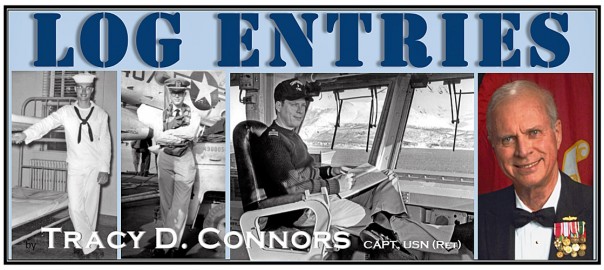Ordering my watch team to maintain constant visual contact on the nearest ships and to continue plotting the “DR” or dead reckoning track as before, I grabbed the brass catch on the voice tube which connected the bridge to the Captain’s Sea Cabin just behind the bridge.
Putting my mouth close to the tube I shouted into it, “Captain, Officer of the Deck, Sir.”
I hoped I sounded professional and not TOO excited. The situation on the bridge was unprecedented—to me at least. I was under orders to advise him of the situation that had clear potential to endanger the ship.
I quickly turned my head to put my ear against the tube to hear his reply. Nothing.
A little more PROFESSIONALLY, I shouted into the tube, “Captain, OFFICER OF THE DECK, SIR.”
Surely, that would get his attention. I hoped he wouldn’t be angry at me for yelling in his ear. This time, as I listened for his reply, at first I heard nothing. Then, a faint sound. Gentle snoring. He was out like a light. Damn!
Raising up from the voice tube, I scanned the horizon. Still full of moving ships.
Over to the 21MC announcing system, I called Main Control.
Yes, they assured me, they were working the power problem. The juice would be back on in just a few minutes.
At this point I was considerably worked up. While it didn’t look as though we were about to have a head on collision or run down some tramp steamer, I knew I had to get the Captain out on the bridge. This was one situation definitely not covered in the Night Order Book or the Regs.
I told the Junior OOD that I would be right back. I was going to get the Captain myself. I could have sent the messenger of the watch, but I felt I had to make a personal report if that were needed.
Dodging past the helmsman, I almost ran to the Captain’s little sleeping room just behind the bridge. My first knock brought no answer. The second pounding brought a muffed “come in.”
I opened the door just a crack and told the Captain we had lost power and that he was needed on the bridge. I didn’t give him a chance to answer before I was heading back to my post.
Soon after I reached the bridge, the power came back on. The status board glowed again with X’s and tracks, except they had no relation at all to the lights out beyond the ship. The “blips” on the radar could not be matched up to the tracks we had maintained prior to the power loss. Any one of the glowing points on the screen could be a problem or a threat. Luckily, up to that point we had not seen any red and green running lights coming at us, meaning that nothing was approaching us more or less head on.
Scrub the tracks I told the Seaman. The status board was now empty. Starting with contacts directly ahead, I had the JOOD take bearings and we began to reclassify contacts. CIC gave them the same names and we began to create solutions from ranges and bearings which told us their course, speed and how close they were going to pass to us.
Continued on Page 6 below…
© Copyright 2018 BelleAire Press
Other works by Dr. Connors…
Baited Trap, the Ambush of Mission 1890
Now Available As E-Pub

Baited Trap, The Ambush of Mission 1890 is the story of helicopter rescue Mission 1890, one of the most heroic—and costly—air rescues of the Korean War. This harrowing Air Force-Navy mission is explained in compelling detail, creating a detailed personal account of what five incredibly brave and determined Air Force and Navy airmen achieved on June 25, 1952 in the infamous “Iron Triangle.”
The Korean War’s Greatest Love Story
Baited Trap is much more than a heroic war story from the “forgotten war.” It is also the Korean War’s greatest love story, following Wayne and Della Lear, Bobby Holloway, Ron Eaton and Dolly Sharp, and Frankie and Archie Connors as they tried to put their lives and families together even as the Korean War was reaching out to engulf them.
Truckbusters From Dogpatch: the Combat Diary of the 18th Fighter-Bomber Wing in the Korean War, 1950-1953

Truckbusters from Dogpatch is the most comprehensive Korean War unit history yet prepared–over 700 pages summarizing squadron histories and first person accounts—and includes over 1,000 never before published photographs and images, highlighted by the 8 ½ x 11-inch format.
Arguably, Truckbusters From Dogpatch is the most authoritative unit history ever prepared on the Korean War. In addition to consulting formerly classified squadron histories filed monthly throughout the conflict, the author was in touch with hundreds of veterans of the 18th—pilots and ground crew—whose personal recollections add vivid detail and emotion to the facts recounted in the official documents.
Recent Log Entries by CAPT Connors…
Carrier Captain’s Night Orders: “Call Me…”
After reading these Night Orders you can better appreciate what training, attention to duty, and vigilance was required by underway watchstanders in those days. What has changed since then that has resulted in the recent tragic collisions between U.S. Navy ships and other vessels?
“We do it all!” (USS Saipan LHA-2 motto)
Saipan CO, CAPT Jack Renard, was not exaggerating when he noted that “without exception, SAIPAN is the most versatile instrument of peace or war on the seas today.” Like its motto pointed out, SAIPAN could do it all.
